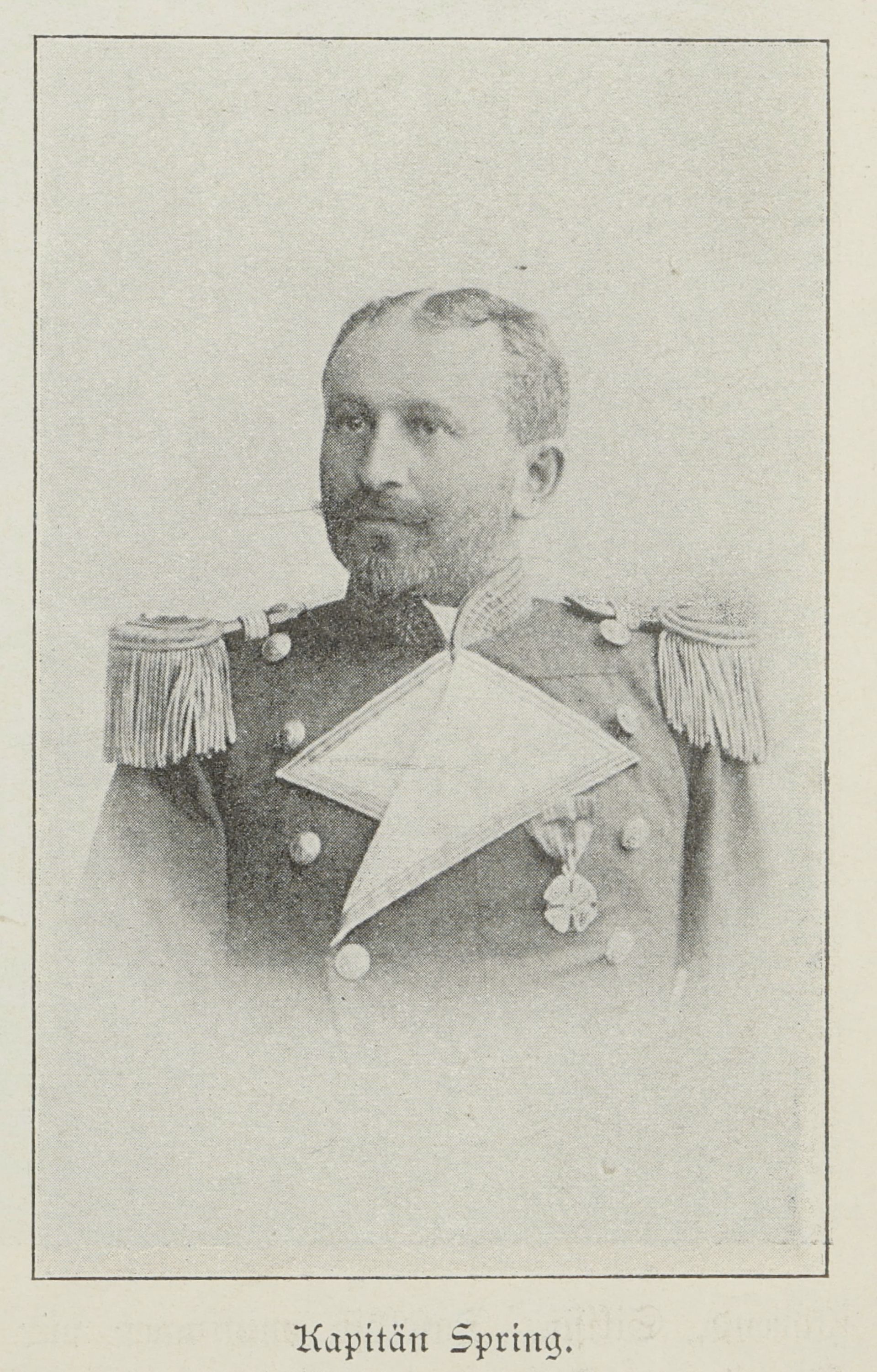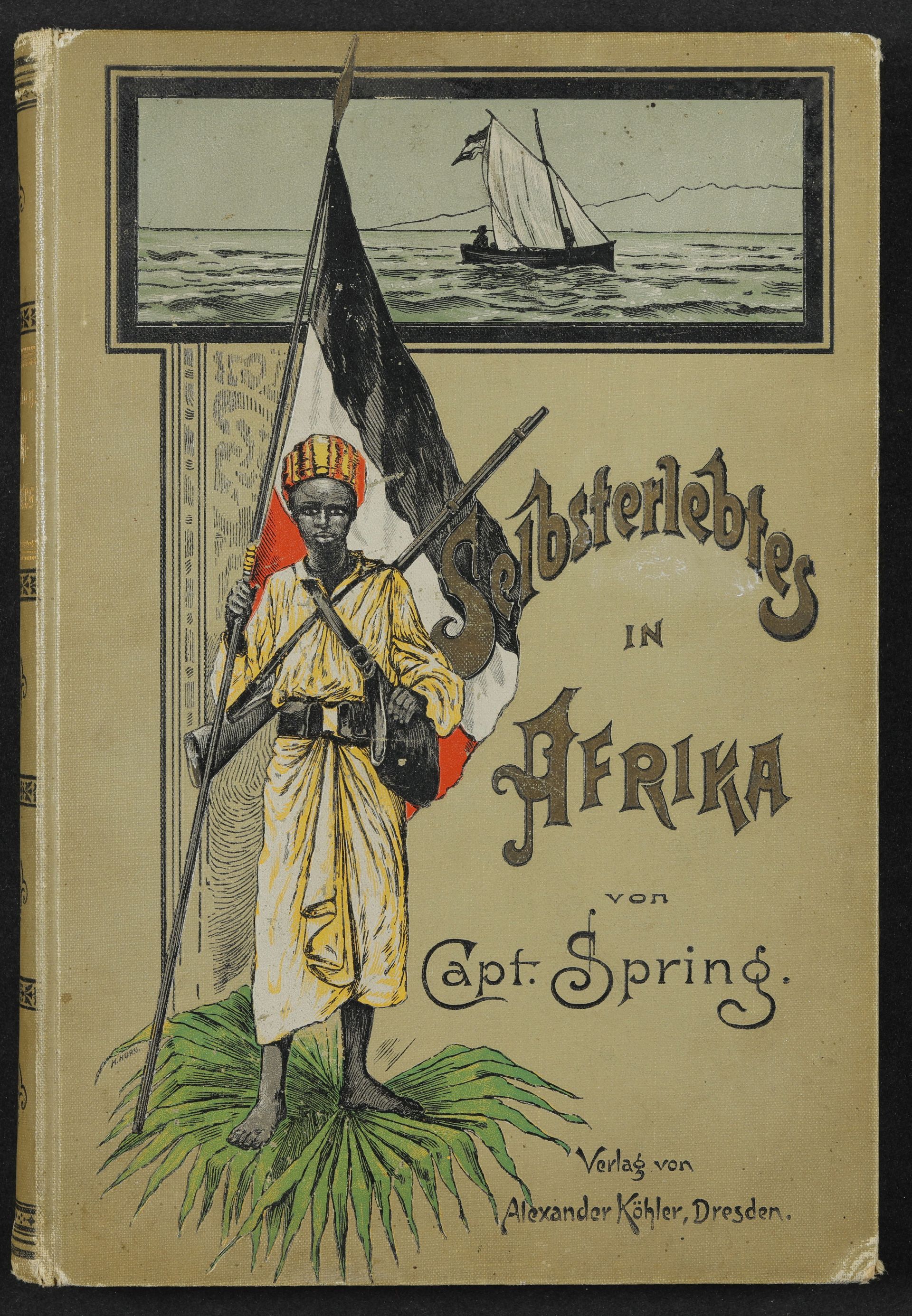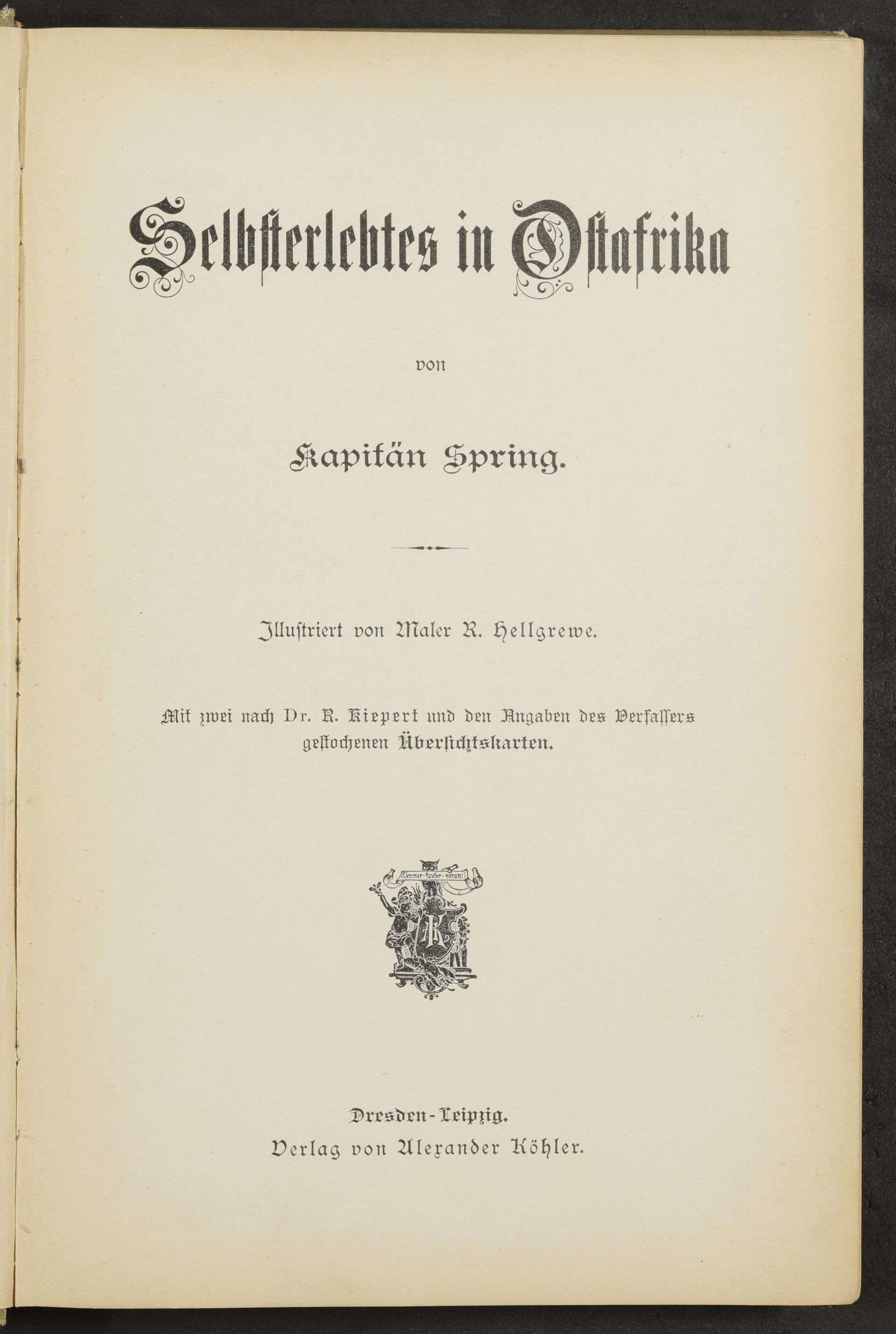Die Objekte, die Spring dem Großherzog Adolphe schenkte wurden durch die Vermittlung des damaligen Staatsministers Paul Eyschen an die Section Historique weitergebeben. Diese wollte damals ein kleines ethnographisches Museum einrichten, das die Sammlungen zur luxemburgischen Geschichte ergänzen sollte. Der Kurator der Section historique, Nicolas van Werveke erwähnt die Objete das erste Mal in seinem Jahresbericht zum Jahr 1896, was bedeutet, dass sie sich mindestens seit diesem Jahr in Luxemburg befinden. Die detaillierte Beschreibung schrieb er zwei Jahre später, wobei er sich sicherlich auf Angaben des Schenkers Albert Spring bezog. Es handelt sich hauptsächlich um Lanzen, Speere und andere traditionelle Waffen, aber auch um zivile Objekte wie Trommeln, Rasseln, Stühle, Matten, Amulette, Vasen, Schmuck, Schnupftabakdosen usw. Die von van Werveke im Inventar erwähnten Volks- und Ortsnahmen weisen darauf hin, dass die Objekte aus Zentral- und Ostafrika stammen. Sie stammen mit denen der Regionen überein, die Spring 1892-1893 durchquerte.
Geraubte Objekte : Die Albert Spring Sammlung
Geraubte Objekte : Die Albert Spring Sammlung
1896 übergab ein gewisser Albert Spring der Section historique einige Objekte, die er zwischen 1892 und 1893 in Deutsch Ostafrika (heute Tansania) gesammelt hatte. Dies war die Zeit der kolonialen Eroberung Ostafrikas durch die Deutschen, somit muss der Erwerb dieser Objekte in jedem Fall als problematisch angesehen werden. Tatsächlich hat das MNAHA, mit der Unterstützung des Kulturministeriums, das Nationalmuseum in Dar-es-Salam mehrmals zu diesen Objekten kontaktiert, um die Kollegen dort auf ihre Existenz hinzuweisen und um seine Bereitschaft für jedes gemeinsame Projekt, inklusive einer Restitution, zu signalisieren.
Kurze Biographie Albert Springs
Es ist uns nicht bekannt, warum Albert Spring diese Objekte ausgerechnet dem Großherzog Adolphe von Luxemburg schenkte – er machte später mehrere Schenkungen an deutsche Museen (u.a. in Berlin und Stuttgart). Spring, Kapitän der Handelsmarine, geboren 1861 in Neuwied (D) und gestorben 1917 in Berlin, scheint weder in Luxemburg gelebt noch Verwandte hier gehabt zu haben.
Allerdings war er aktiver Kolonialist. Neben der Reise nach Deutsch-Ostafrika 1892-1893, unternahm er 1886-1887 eine Entdeckungsreise ins damals deutsche Kamerun, arbeitete 1893 für eine portugiesische konzessionierte Gesellschaft in Mozambique und kehrte 1909 dorthin zurück, um die lokale Fauna zu dokumentieren und um Jagtausflüge für europäische Reisende zu organisierten. Während seiner langen Aufenthalte in Europa hielt er zahlreiche Vorträge, sowohl für wissenschaftliche Gesellschaften als auch für ein breites Publikum bei denen er die koloniale Ideologie verbreitete. Seine Reisen fanden allesamt in der Zeit der europäischen kolonialen Expansion in Afrika statt, in dem die Lage dadurch sehr unsicher und die Beziehungen zwischen Europäern und Afrikanern von großer Gewalt geprägt sind.
 Albert Spring
Albert Spring
Erwerb der Spring Sammlung durch die Section Historique 1896
Sammlung der Objekte durch Albert Spring
Die Quellen zeigen, dass Spring die meisten Objekte, die sich heute noch im MNAHA befinden, während seiner Afrikareise von 1892-1893 erwarb. In seinen Memoiren gibt er zwar an, dass sie ihm von diesem oder jenem afrikanischen „Sultan“ „gegeben“ worden wären, allerdings fand seine Reise zu einer Zeit statt in der die Deutschen die Gebiete mit Gewalt unter ihre Herrschaft brachten. Stammen die Objekte also von Völkern, die mit den Deutschen befreundet oder verbündet waren können wir davon ausgehen, dass es sich in der Tat um Geschenke handelt. Sind es jedoch Objekte von verfeindeten Völkern, müssen wir davon ausgehen, dass sie in gewaltvollen Umständen erworben wurden, wie es bei nun vorgestellten Objekten der Fall ist.
 Albert Spring
Albert Spring
 Albert Spring
Albert Spring
Objekte der Nyamwezi
Am 4. Juni 1892 wurde Spring, der sich zu dem Zeitpunkt am Posten der Tabora befand, vom dort stationierten deutschen Militärkommandanten eingezogen um diesem beim Kampf gegen den Oberen Isike aus Unyanyembe, – den die Deutschen Sikki nannten. Isike war einer der wichtigen Oberhäupter der Nyamwezi, dem die Deutschen vorwarfen regelmäßig ihre Karawanen anzugreifen. In seinem Bericht der Ereignisse erwähnt der Kommandant Schwesinger, dass Isike es geschafft hatte die Oberhäupter einiger benachbarter Regionen gegen die Deutschen zu mobilisieren was die totale Isolation der Deutschen in Tabora zur Folge gehabt hätte. Bei der Attacke am Abend des 4. Juni 1892 schafften es die Deutschen tatsächlich in die befestigte Siedlungsanlage einzudringen, die Isike in Tabora hatte bauen lassen. Allerdings schafften sie es nur materielles zu erbeuten, ohne den Sultan und seine Gefolgschaft gefangen nehmen oder töten zu können. Im Gegensatz zu der Darstellung in der deutschen Presse, war der Angriff also kein Erfolg für die Deutschen. Ein paar Tage später erreichte sie der Leutnant Ludwig Meyer und es wurde beschlossen keinen zweiten Angriff auf Isikes Siedlung zu versuchen und stattdessen ein paar ihm treue umliegende Dörfer niederzubrennen und zu zerstören. Es ist sehr wahrscheinlich, dass einige der Objekte der Nyamwezi, die sich heute in Luxemburg befinden, bei dieser Gelegenheit erbeutet wurden. Spring erwähnt in der Tat seine aktive Beteiligung an diesen Angriffen in seinen Memoiren.
Es handelt sich insbesondere um die „Heilige Lanze des Sultan Sicki von Tabora“ und um die „Kriegstrommel des Sultan Sikki von Tabora“. Die Beschreibungen, die van Werveke in seinem Inventar macht erlauben es zumindest diese zwei Objekte in dem Kontext der Attacke auf die Siedlung Isikes zu verorten. Sie sind also zweifellos Kriegsbeute. Sogar wenn die Trommel, die sich im MNAHA befindet, nicht Isike selbst gehört hat, war sie zumindest die eines seiner Gefolgsleute.
Der Ring des Mwinyi Mtwana
Am 1. Juni 1893 druckte das Luxemburger Wort den Brief der Frau eines deutschen Offiziers in Afrika, In diesem beschreibt er eine Strafexpedition gegen einige Dorfbewohner, die eine deutsche Karawane angegriffen haben sollen. Da die Deutschen das Dorfoberhaupt nicht finden konnten töteten sie einen seiner Verbündeten, sowie dessen Ehefrau und Vater. Dieses von den Deutschen hingerichtete Oberhaput hieß Mninitwana (oder Mwinyi Mtwana, wie er in der wissenschaftlichen Literatur bevorzugt geschrieben wird). Ursprünglich Händler an der Ostküste, hatte er von dort flüchten müssen, da er seine Schulden nicht bezahlen konnte. Er ging ins Landesinnere, wo er weiter handelte und kämpfte. Hier wurde er ein Verbündeter des Sultans von Zanzibar, im Namen dessen er die arabischen Karawanen beschütze. Dabei wurde er unumstrittenes Oberhaupt der Region rund um das Dorf Mdaburu.
In den 1880er Jahren jedoch löste sich Mwinyi Mtwana von Zanzibar und begann Schutzgebühren zu verlangen, erst von den arabischen Karawanen, die dann auf andere Routen auswichen, und dann auch von den europäischen, die er aber weiterhin freundlich empfing. Um 1891 verbündete er sich aber mit den Hehe, die sich gegen die Deutschen stellten. Damit wurden Mwinyi Mtwana und sein Sohn, dessen Männer oft Karawanen angriffen die durch die Region reisten, zu Angriffszielen der Deutschen.
Als Spring auf seinem Rückweg zur Küste durch die Region reiste bot sich die Gelegenheit zum Angriff. Unter dem Kommando der Offiziere Tom von Prince und Alfred Sigl erreichten die Deutschen und ihre Verbündeten Mdaburu in der Nacht vom 10. auf den 11. März 1893. Ihre Truppe setze sich aus fünf europäischen Offizieren und 126 askaris aus der regulären deutschen Armee zusammen. Sie wurden von Spring und seinen 24 afrikanischen Söldnern sowie etwa 100 Kriegern, die schnell im Umfeld rekrutiert wurden unterstützt. Der Angriff auf das Lager Mwiniy Mtwanas begann gegen drei Uhr in der Früh, als die Dorfbewohner schliefen. Sowohl die Hehe Krieger als auch Mwiniy Mtwanas Leibgarde wurden bald überwältigt. Die Hütten wurden systematisch eine nach der anderen angezündet, was ihre Bewohner zwang ins Freie zu fliehen und sich zu ergeben. Der Sultan und sein Vater wurden so bei der Zerstörung einer der ersten Hütten gefangen genommen. Laut Spring war die Attacke um 8 Uhr am Morgen vorbei. Nun nahmen sich die Deutschen Zeit, um die reiche Beute zu bewerten, die sie in der Mitte des Dorfes angesammelt hatten: Gewehre, eine kleine Kanone, eine Mauser Pistole, die bei einer Attacke auf eine deutsche Karawane erbeutet worden war, die Flagge Mwiniy Mtwanas, Schmuck und die Schilder der Hehe – von denen sich manche womöglich heute im MNAHA befinden. Die Offiziere verurteilten anschließend den Sultan und seinen Vater zu Tode durch Erschießung. Sofort wurde das Urteil auch vollzogen.
Schlussfolgerung
Wie hier gezeigt wurde, ist nicht daran zu zweifeln, dass die Objekte, die auf Mdaburu und Mwiniy Mtwana zurückzuführen sind und als solche im Inventar von Nicolas van Werveke aufgeführt sind, bei der auf die Hinrichtung folgende Plünderung des Dorfes erbeutet wurden. Es ist ebenfalls sehr wahrscheinlich, dass die Lanzen und Schilde, die van Werveke den Gogo (Wagogo) und Hehe (Wahehe) zuschreibt, zumindest teilweise, bei der Attacke auf das Dorf erbeutet wurden.
Somit ist klar, dass sich Kriegsbeute aus Kolonialkriegen auch in Luxemburg befindet. Luxemburg ist aber durchaus bereit, wie oben gesagt, diese Objekte zurückzuerstatten.
Text | CC BY-NC | Régis Moes, MNAHA
Quellen
Bericht des Sekretär-Kurators, Publications de la Société historique (PSH), Volume XLV, 1896.
Beschreibender Katalog der ethnographischen Sammlung Springs in Bericht des Sekretär-Kurators, Publications de la Société historique (PSH), Volume XLVI, 1898.
Reisebericht Albert Springs, Selbsterlebtes in Ostafrika, Dresde et Leipzig, Köhler, 1896. (Bibliothekskatalog)
'Verschiedene Nachrichten'. In: Luxemburger Wort, 1893. Jg., nº 152 (01.06.1893). [Digitalisiert von der Nationalbibliothek Luxemburg]. (voller Text, letzter Aufruf: 01.07.2024)
Benett, Norman R., 'Mwinyi Mtwana and the Sultan of Zanzibar', in: Benett, Norman R., Studies in East African History, Boston, Boston University Press, 1963.
Benett, Norman R., 'Arab versus European'. Diplomacy and War in the nineteenth-century East Central Africa, New York, Africana Publishing Company, 1986.
Veröffentlichungsdatum: 28. September 2023
Letzte Aktualisierung: 1. Juli 2024

